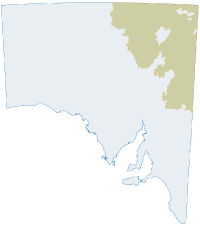 Age of major events
Age of major events
- Late Paleocene to Holocene
Prospective commodities
Uranium, heavy mineral sand, palygorskite, celestite
Major exploration models
- Paleochannel-hosted roll-front uranium
- Paleochannel-hosted palygorskite
- Paleochannel-hosted placers (heavy mineral sand)
Summary geology
Deep weathering profiles developed in pre-Cenozoic rocks in inland SA, with concentration of iron oxide and silica forming duricrusts (ferricrete and silcrete) which characterise much of inland South Australia. Tertiary sediments are widespread on this weathered pre-Cenozoic landscape of South Australia. In the basins of inland South Australia (including the Lake Eyre Basin), and in paleochannels, relatively thin, fluvial and lacustrine, carbonaceous, sandy, clayey and carbonate sediments were deposited in lacustrine and fluvial settings.
Lake Eyre Basin in SA comprises a thick (>400 m) sedimentary succession in a northeastern depocentre that thins and becomes discontinuous towards the southwest. The basin is separated into the Tirari and Callabonna Sub-basins by the Birdsville Track Ridge, which is expressed at the surface by silcrete-capped (Cordillo, Gason and Cooryanna) domes of Mesozoic sediments.
The Callabonna Sub-basin contains economic paleochannel-hosted sedimentary uranium deposits including Beverley, Honeymoon, Four Mile East, Pepegoona and Pannikin. The Lake Eyre Basin has occurrences of heavy mineral sand, celestite (see Mesozoic Basins section) and palygorskite.
Stratigraphy and geological history
Three sedimentary phases occurred in the Lake Eyre Basin: 1) latest Paleocene to Middle Eocene sandstone, carbonaceous clastics and conglomerate of the Eyre Formation deposited in extensive fluvial environments; 2) Early Miocene to Pliocene clay, sand and carbonate of the Etadunna and Namba Formations deposited in extensive lakes and associated fluvial and shoreline environments; 3) Pliocene to Quaternary fluvial, aeolian and playa lake sediments.
During the late Paleocene, tectonic subsidence in northeastern South Australia formed the large, shallow Lake Eyre Basin. There is little evidence for deposition between the late Eocene and late Oligocene as a result of widespread gentle folding and uplift. During this period, rejuvenation of the Birdsville Track Ridge formed silcrete-capped domes and divided the basin into its two sub-basins.
The Quaternary Period was a time of marked climatic and sea-level fluctuations. In the interior, widespread sand deserts of longitudinal dunes formed during arid phases that alternated with periods of moister climate when fluvial and lacustrine sedimentation was more extensive.
Further reading
Alley NF and Lindsay JM 1995. Tertiary. In JF Drexel and WV Preiss (Eds), The geology of South Australia, Volume 2, The Phanerozoic. Bulletin 54:150–217. Geological Survey of South Australia.
Alley NF 1998. Cainozoic stratigraphy, palaeoenvironments and geological evolution of the Lake Eyre Basin. Palaeogeography, Palaeoclimatology, Palaeoecology 144:239–263.
Belperio AP 1995. Quaternary. In JF Drexel and WV Preiss (Eds), The geology of South Australia, Volume 2, The Phanerozoic. Bulletin 54:218–280. Geological Survey of South Australia.
Callen RA, Alley NF and Greenwood DR 1995. Lake Eyre Basin. In JF Drexel and WV Preiss (Eds), The geology of South Australia, Volume 2, The Phanerozoic. Bulletin 54:189–194. Geological Survey of South Australia.
Hou B, Michaelsen B, Li Z, Keeling JL, Fabris A and the participants of IGCP-514 2014. Paleovalley-related uranium: exploration criteria and case-studies from Australia and China. Episodes 37(3):150–171.


